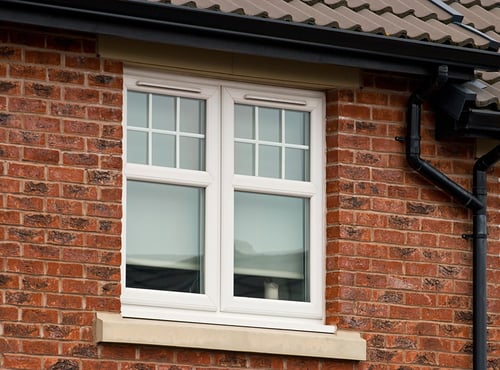The Effect of Windows on Building Performance

Windows are often viewed as decorative elements of a building, with the passive role of providing visibility and natural lighting. However, the choice of windows is a very important design decision before construction. A high portion of heat exchange between the building and the exterior happens through windows, and this influences the energy consumption of heating and cooling equipment.
Defining an adequate number of windows and their layout is a design challenge:
- A large number of windows provides abundant daylight, which reduces lighting expenses.
- However, abundant windows also increase summer heat gain and winter heat loss, driving up HVAC expenses.
- Also, if windows are placed where they face the sun directly, they can cause glare.
Improve the insulation and air-tightness of your building envelope.
Thermal Performance of Windows
A window’s resistance to heat flow is determined by its physical construction: double-pane glass transfers less heat than a single-pane glass, and in turn a double-pane window is outclassed by a triple-pane window. As you might expect, the window cost increases along with the number of glass panes, which means there is a cost-benefit analysis involved. According to MyHomeQuote, you can use a cost calculator to get a better understanding of the pricing.
Three main metrics are used to describe the thermal performance of windows: the U-value, the R-value and the solar heat gain coefficient (SGHC).
The U-value is the heat transfer coefficient, and it describes the heat transferred per unit of area and per unit of temperature difference. If a window as a U-value of 0.25 W/m2-°C, a window area of 2 m2 will transfer 5 watts when exposed to a temperature difference of 10°C.
- Heat transfer = (0.25 W/m2-°C)(2 m2)(10 °C) = 5 W
The R-value describes the thermal resistance, and it can be obtained dividing the number 1 by the U-value. For instance, a U-value of 0.25 W/m2-°C is equivalent to an R-value of 4 m2-°C/W.
- R-value = 1 / U-value = 1 / (0.25 W/m2-°C) = 4 m2-°C / W
Heat transfer can also be calculated from the R-value, applying the following formula:
- Heat transfer = Area x Temperature Difference / R-value
- Heat transfer = (2 m2)(10°C) / (4 m2-°C/W) = 5 W
The solar heat gain coefficient (SHGC) is the fraction of solar radiation transmitted by the window. For instance, if a window has an SHGC of 0.7 and it receives 200W of solar radiation, the heat transmission is 140W (200W x 0.7).
Enhancing Natural Lighting and Preventing Glare
Natural lighting with windows reduces the dependence on lighting fixtures, lowering the running cost of artificial lighting. However, poorly placed windows can cause glare if the sun is directly visible or reflected by an interior surface. The distraction caused by glare lowers productivity, and long-term exposure is harmful for human vision. Note that there are two types of glare:
- Discomfort glare happens when a bright source of light causes pain and and instinctive reaction to look away. For example, this is the type of glare experience if you look at the sun accidentally.
- Disability glare occurs when vision is hindered, but without the instinctive reaction to look away. A common example is when a light source is reflected on the screen of a TV or a computer - there is no visual pain, but the images on the screen cannot be seen clearly.
Glare can be prevented by avoiding windows that face the sun directly, or by blocking it strategically with vegetation and window shades. Skylights are also viable when there is no floor above - their geometry is optimized to allow natural lighting without the glare and heating effects.
Artificial lighting can be enhanced with controls to make it responsive to natural lighting, through a concept called daylight harvesting. Lighting fixtures are dimmed or deactivated in response to natural lighting, and their electricity consumption is lowered as a result.
Effect on Windows on Heating and Cooling Expenses

A building can be equipped with the most efficient heating and cooling systems available, but performance will still be poor if the building envelope lacks adequate insulation and air tightness. A large fraction of summer heat gain and winter heat loss occur at windows, and the effect on energy bills can be significant if the thermal performance of windows is low.
High-performance windows are easier and less expensive to install in a new building, since there is no need to modify existing walls. A window upgrade project becomes more expensive in an existing building, since the current windows must be removed and there is also masonry work. Storm windows are a cost-effective option in existing buildings: they can be installed without disrupting the existing windows, and the resulting air gap between the old window and the storm window improves insulation.
Conclusion
Energy efficiency measures tend to focus on specific building systems, but a better approach is working with the overall performance of building. With smart window selection and an adequate layout, windows can reduce lighting expenses, while minimizing glare and HVAC costs. On the other hand, careless use of windows can work against energy efficiency upgrades, reducing the return on investment.

Anuj Srivastava
Anuj Srivastava is a principal partner at NY Engineers. He is known for his MEP franchise market knowledge. Anuj is currently leading a team of 100+ MEP/FP engineers and has successfully led over 1500 franchise projects in the US.
Join 15,000+ Fellow Architects and Contractors
Get expert engineering tips straight to your inbox. Subscribe to the NY Engineers Blog below.



